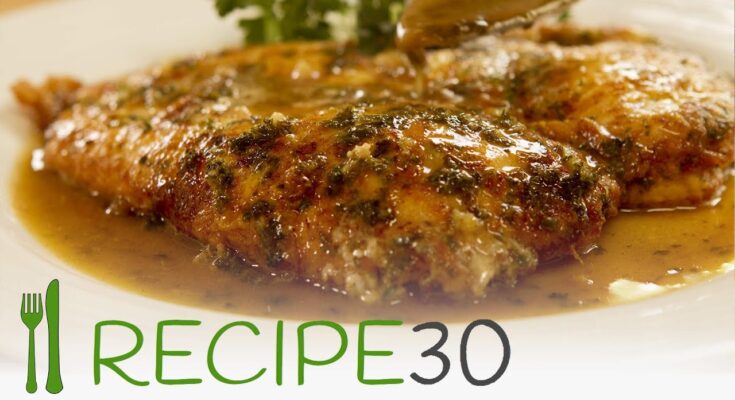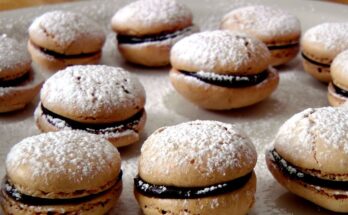Chicken Francaise Recipe: Chicken Francaise, also spelled Chicken Française, is a delicate yet bold Italian-American dish made by dredging chicken cutlets in flour, dipping them in egg, and pan-frying until golden. It’s then bathed in a tangy lemon-butter-wine sauce that makes your taste buds do a happy dance. What sets it apart is the unique egg batter, which gives it a rich texture and depth of flavor that’s unlike most other chicken recipes.
Despite its elegant flavor, Chicken Francaise is incredibly easy to whip up. It only takes about 30 minutes to prepare, making it perfect for weeknight dinners or special occasions. The bright citrusy sauce and tender, juicy chicken create a well-balanced, unforgettable meal that’s sure to impress.
History and Origin
Chicken Francaise has a fascinating backstory. While the name suggests French roots, it’s actually a creation from Italian-American kitchens. The technique was inspired by the French method of cooking proteins with egg and flour, but it was the Italian immigrants who made it a household name in American cuisine, particularly in the Northeast.
Originally, the recipe was made with veal (Veal Francaise), but due to cost and accessibility, chicken quickly took over as the protein of choice. Over time, Chicken Francaise became a beloved staple in diners, family restaurants, and Sunday dinner tables.
Ingredients Needed for Chicken Francaise
Essential Ingredients
To make an authentic Chicken Francaise, you’ll need the following essentials:
- Boneless, skinless chicken breasts – Typically sliced thin or butterflied
- All-purpose flour – For dredging the chicken
- Large eggs – Used in the batter coating
- Salt and black pepper – For seasoning
- Garlic powder (optional) – Adds extra depth to the seasoning
- Olive oil and unsalted butter – For pan-frying
- Fresh lemon juice – The star of the sauce
- Chicken broth – Adds savory flavor to the sauce
- Dry white wine – For deglazing and enhancing sauce flavor
- Fresh parsley – For garnish and a pop of color
Each ingredient plays a vital role in creating that signature taste and texture. Don’t skimp on the fresh lemon juice—it gives the sauce that vibrant, mouthwatering finish that makes Chicken Francaise unforgettable.
Optional Add-ons for Enhanced Flavor
Want to elevate your Chicken Francaise to restaurant-level goodness? Consider adding:
- Capers – For a briny, savory punch
- Shallots – Sautéed shallots add sweetness and complexity
- Parmesan cheese – A sprinkle on top adds a nutty, salty finish
- Crushed red pepper – Adds a little kick for spice lovers
These extras aren’t mandatory, but they can bring your dish to the next level depending on your taste preferences.
Tools and Equipment You’ll Need
Before diving in, it’s helpful to gather the right tools:
- Cutting board and sharp knife – To slice and prep the chicken
- Meat mallet or rolling pin – To flatten the chicken evenly
- Mixing bowls – For egg and flour mixtures
- Large skillet or frying pan – Preferably non-stick or stainless steel
- Whisk – For blending eggs and sauces
- Tongs or spatula – To flip and handle the chicken safely
- Citrus juicer or fork – To squeeze fresh lemon juice
- Measuring cups and spoons – Precision is key!
Having these tools ready makes cooking more efficient and enjoyable. There’s nothing worse than scrambling for a whisk with floury hands!
Prepping the Chicken
Choosing the Right Cut
Chicken breasts are the go-to choice for Chicken Francaise, but not just any cut will do. You want boneless, skinless chicken breasts that are either pre-sliced thin or butterflied and pounded to about ½ inch thickness. Why thin? Because it ensures quick, even cooking and a juicy interior with a lightly crisp exterior.
If you’re buying thick cuts, simply slice them in half horizontally to create thinner cutlets. You can also ask your butcher to do this for you if you’re unsure.
Flattening and Seasoning
Once you have your cutlets ready, place them between two sheets of plastic wrap or parchment paper and gently pound them using a meat mallet or rolling pin. The goal is uniform thickness—this helps the chicken cook evenly and stay tender.
Next up, season both sides generously with salt and pepper. You can also add a pinch of garlic powder or Italian seasoning for extra flavor. Don’t go too heavy here—the lemon-butter sauce will do most of the flavor lifting.
Preparing the Egg Wash and Flour Mixture
The hallmark of Chicken Francaise is its unique egg batter. Unlike typical breaded chicken dishes that use breadcrumbs, this one relies solely on a light flour coating followed by an egg dip that results in a delicate, golden crust.
Start by setting up a breading station with two shallow dishes or bowls:
- Bowl 1: All-purpose flour seasoned with a bit of salt and pepper.
- Bowl 2: Beaten eggs—about 2-3 eggs depending on how many cutlets you’re cooking. Add a tablespoon of water or milk to thin it out slightly for easier coating.
Now, dredge each chicken cutlet in the seasoned flour. Shake off any excess, then dip it straight into the egg wash, ensuring it’s fully coated. Let the excess drip off before placing it into the hot pan. This simple two-step coating is what creates that slightly crispy yet custardy outer layer we love in Chicken Francaise.
Pro Tip: Always let the chicken rest for a minute after dipping it in egg so the coating sticks better during frying.
Cooking the Chicken
Pan-Frying the Chicken
Now comes the fun part—bringing that golden, crispy goodness to life. In a large skillet, heat a combination of olive oil and unsalted butter over medium heat. The oil raises the smoke point, and the butter adds that rich, nutty flavor. When the butter starts foaming and sizzling, it’s time to add the chicken.
Place each egg-coated cutlet gently into the pan. Don’t overcrowd the skillet—cook in batches if necessary. Fry each piece for about 3–4 minutes per side, or until golden brown and cooked through.
Flip the chicken carefully using tongs to avoid tearing that delicate crust. The surface should be slightly crispy, lightly browned, and beautifully aromatic.
Achieving the Golden Crust
Getting that iconic golden exterior depends on a few key tricks:
- Make sure your oil and butter are properly heated before adding the chicken.
- Don’t move the chicken around too much—let it sear undisturbed.
- Maintain a steady medium heat to prevent burning or undercooking.
Once done, transfer the cooked cutlets to a paper towel-lined plate or a wire rack. If you’re cooking in batches, keep the cooked chicken warm in a low oven (around 200°F/95°C).
Making the Francaise Sauce
Ingredients for the Sauce
Here’s where the magic really happens. This luscious sauce ties the whole dish together. You’ll need:
- 2 tablespoons unsalted butter
- 1 cup chicken broth (low sodium works best)
- ½ cup dry white wine (like Pinot Grigio or Sauvignon Blanc)
- Juice of 1–2 fresh lemons
- 1 tablespoon all-purpose flour (optional, for thickening)
- Fresh parsley (chopped, for garnish)
- Salt and pepper to taste
Step-by-Step Sauce Instructions
After the chicken is done, remove excess oil from the skillet, leaving behind the flavorful browned bits. These bits, known as fond, are flavor gold.
- Deglaze the pan by pouring in the white wine. Scrape the bottom of the pan with a wooden spoon to lift all that delicious fond.
- Once the wine reduces slightly (about 2–3 minutes), stir in the chicken broth and lemon juice.
- Let the mixture simmer for 5–7 minutes. If you want a thicker sauce, mix a tablespoon of flour with a few drops of water and whisk it into the pan.
- Lower the heat and add the butter. Stir until the butter is fully melted and the sauce looks glossy.
- Taste and adjust seasoning with salt and pepper as needed.
This sauce should be tangy, buttery, and full of depth. If it tastes too sharp, a small splash of cream or a bit of sugar can mellow it out.
Combining Chicken and Sauce
Once your sauce is ready, gently nestle the cooked chicken cutlets back into the pan. Spoon the sauce over each piece, letting it soak in. Simmer on low heat for another 2–3 minutes to allow the flavors to meld beautifully.
Garnish with freshly chopped parsley and a few lemon slices for that extra restaurant-worthy presentation. Serve immediately for best results—this dish is all about enjoying that hot, saucy, crisp-tender chicken while it’s fresh.
Best Side Dishes to Serve with Chicken Francaise
This dish is rich, zesty, and full of flavor, so you’ll want sides that balance it out without overpowering. Here are some fantastic options:
- Mashed potatoes – A creamy, buttery base that soaks up the sauce perfectly.
- Angel hair pasta or linguine – Tossed in a light butter or olive oil, it complements the lemony sauce.
- Steamed green beans or asparagus – Adds a crisp, fresh contrast.
- Rice pilaf – Light and fluffy, it catches every drop of that sauce.
- Crusty Italian bread – For sopping up leftover sauce (because you won’t want to waste a drop).
Pair it with a light white wine like Pinot Grigio or a citrusy Chardonnay, and you’ve got a complete, satisfying meal.
Tips for Perfect Chicken Francaise Every Time
Want to get that restaurant-quality Chicken Francaise right in your own kitchen? Here are some practical tips to ensure you nail it every single time:
- Use fresh lemon juice – Bottled lemon juice just doesn’t cut it. Freshly squeezed lemons give the sauce its bright, tangy zing.
- Don’t skip the egg wash – It might seem unusual, but the egg coating is what gives the chicken that soft, almost velvety texture. Skipping it will leave you with just another fried chicken dish.
- Maintain medium heat – High heat will burn the delicate egg coating before the chicken is fully cooked. Keep your pan at a medium temperature for that perfect golden-brown finish.
- Deglaze properly – Scraping the browned bits off the bottom of the pan after cooking the chicken adds incredible depth to your sauce.
- Finish with butter – That final swirl of butter at the end of the sauce gives it a luxurious finish that feels like it came out of a fine dining kitchen.
Also, timing is everything. Don’t let the chicken sit too long after it’s sauced—serve it immediately while it’s still crisp and hot for the best experience.
Common Mistakes to Avoid
Even a simple recipe like Chicken Francaise can go sideways if you’re not careful. Watch out for these common pitfalls:
- Overcooking the chicken – Thin cutlets cook fast. Leaving them on the stove too long will dry them out. Aim for 3–4 minutes per side.
- Too much flour – Make sure to shake off excess flour before dipping into the egg wash. Otherwise, the coating can turn gummy instead of light and crisp.
- Using too much lemon – Yes, it’s a lemony dish, but don’t go overboard. Too much acid will overpower the sauce. Start with one lemon and adjust to taste.
- Skipping the wine – If you’re tempted to skip the wine, don’t! It’s essential for flavor. If you prefer not to use alcohol, substitute with extra broth and a splash of white wine vinegar or lemon juice.
- Not resting the chicken – Letting the chicken rest for a minute before frying helps the egg coating set, giving it better adherence and texture.
Being mindful of these issues helps transform a decent dish into an exceptional one.
Storing and Reheating Leftovers
Chicken Francaise is best fresh, but if you have leftovers, they can still be delicious the next day with a few storage tips:
- Storing: Let the chicken cool completely before transferring it to an airtight container. Store the sauce separately if possible. Refrigerate for up to 3 days.
- Reheating: To maintain crispiness, reheat the chicken in a skillet over medium heat. Add a bit of broth or leftover sauce to the pan and cover loosely with foil. This gently steams the chicken while keeping the crust intact.
- Microwave method: If you’re in a rush, reheat the chicken in the microwave, but expect a slightly softer crust. Use short intervals and cover with a damp paper towel to retain moisture.
- Freezing: You can freeze Chicken Francaise, but it’s not ideal. The texture may suffer after thawing due to the egg coating. If you must freeze, wrap tightly in foil and freeze up to 2 months. Reheat from frozen in a covered baking dish at 350°F.
The sauce can be refreshed with a pat of butter or squeeze of lemon when reheating.
Variations of Chicken Francaise
While the classic version is perfect, there are many ways to put your own spin on this dish:
- Veal Francaise: The original version made with thin veal cutlets instead of chicken.
- Fish Francaise: Use firm white fish like flounder or sole—perfect for seafood lovers.
- Gluten-Free Francaise: Swap out regular flour for a gluten-free blend, and you’re good to go.
- Herbed Francaise: Add chopped fresh herbs (like basil, thyme, or tarragon) to the egg wash for an herby kick.
- Creamy Francaise: Stir a splash of cream into the sauce at the end for a richer, velvety twist.
- Spicy Francaise: Add red pepper flakes to the sauce or season the flour with cayenne for a touch of heat.
These variations allow you to adapt the recipe based on dietary needs, preferences, or just to switch things up.
Final Thoughts and Serving Suggestions
Chicken Francaise is more than just a meal—it’s a comforting, restaurant-quality experience made right at home. Its tender, golden chicken cutlets soaked in that lemony, buttery sauce make it unforgettable every single time. Whether you’re hosting a dinner party or just looking to treat yourself to something amazing, this dish delivers every time.
Pair it with a crisp white wine, a side of al dente pasta, or creamy mashed potatoes, and you’re all set. Add a few lemon slices and some chopped parsley on top for that final touch of elegance.
And remember—it’s not about perfection, it’s about flavor, fun, and the joy of sharing food with people you love.
FAQs about Chicken Francaise Recipe
Q1: What is Chicken Francaise made of?
Chicken Francaise is made with boneless chicken breasts, flour, eggs, lemon juice, butter, garlic, chicken broth, and fresh parsley. It’s known for its light, lemony sauce and golden, pan-fried chicken.
Q2: Is Chicken Francaise the same as Chicken Francese?
Yes, both names refer to the same dish. “Francaise” is the French spelling, while “Francese” is the Italian-American version. They are used interchangeably.
Q3: Can I use chicken thighs instead of breasts?
Yes, you can substitute boneless, skinless chicken thighs for breasts. Just ensure they are pounded thin for even cooking.
Q4: What sides go well with Chicken Francaise?
Popular sides include mashed potatoes, rice, pasta, or steamed vegetables. A crisp green salad also complements the flavors well.
Q5: Can Chicken Francaise be made ahead of time?
Yes, you can make it ahead and reheat gently on the stovetop. However, it’s best served fresh to maintain the crisp coating.
Q6: Is Chicken Francaise gluten-free?
Not traditionally, since it uses flour. But you can use a gluten-free flour blend to make it suitable for gluten-free diets.
Q7: How do I thicken the sauce if it’s too runny?
Simmer the sauce a bit longer or add a cornstarch slurry (1 tsp cornstarch + 1 tbsp water) to help it thicken.
Q8: Can I freeze Chicken Francaise?
Freezing is possible, but the texture may change. It’s best to freeze only the cooked chicken and make the sauce fresh when reheating.
Conclusion
Chicken Francaise is a dish that hits all the right notes—zesty, savory, comforting, and oh-so-satisfying. With simple ingredients and a step-by-step approach, you can recreate this restaurant favorite any night of the week. Just follow the guide, stay patient, and savor the delicious results.



